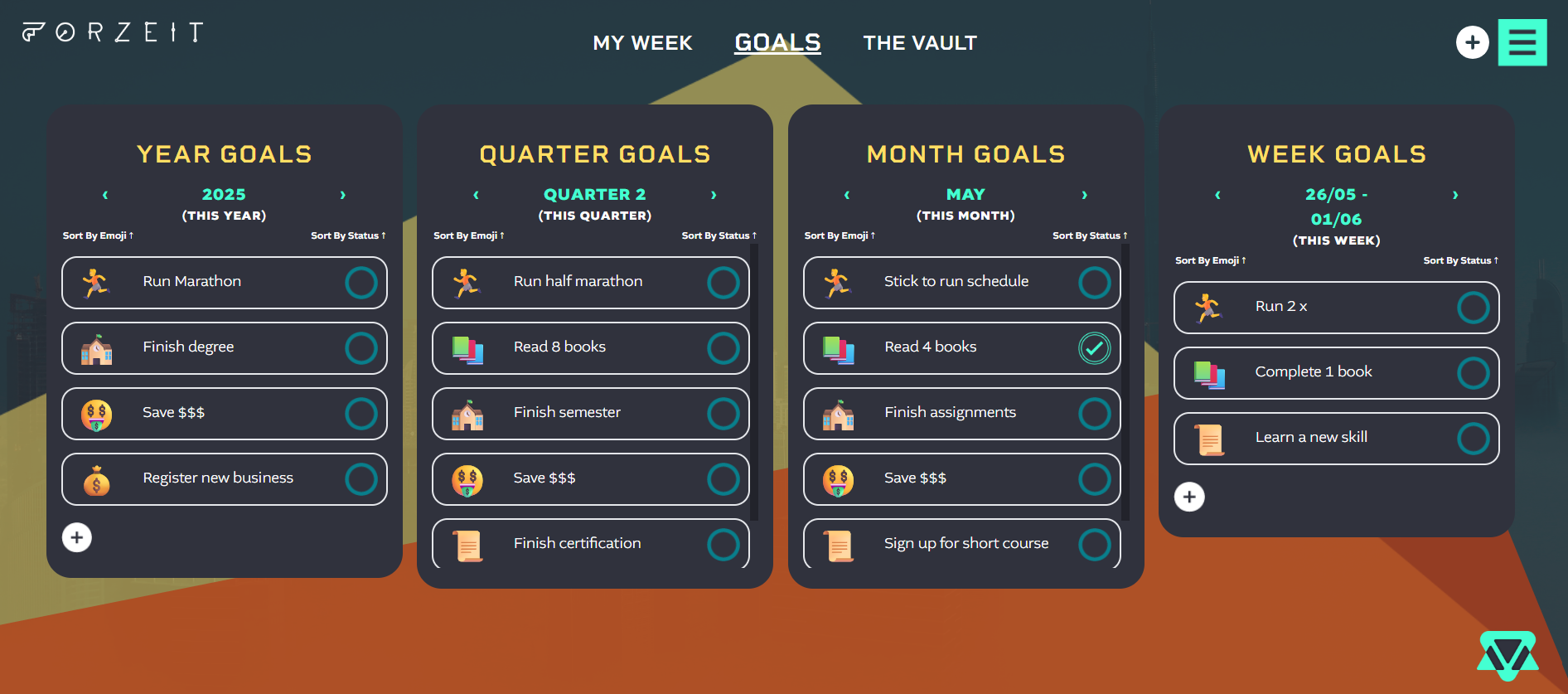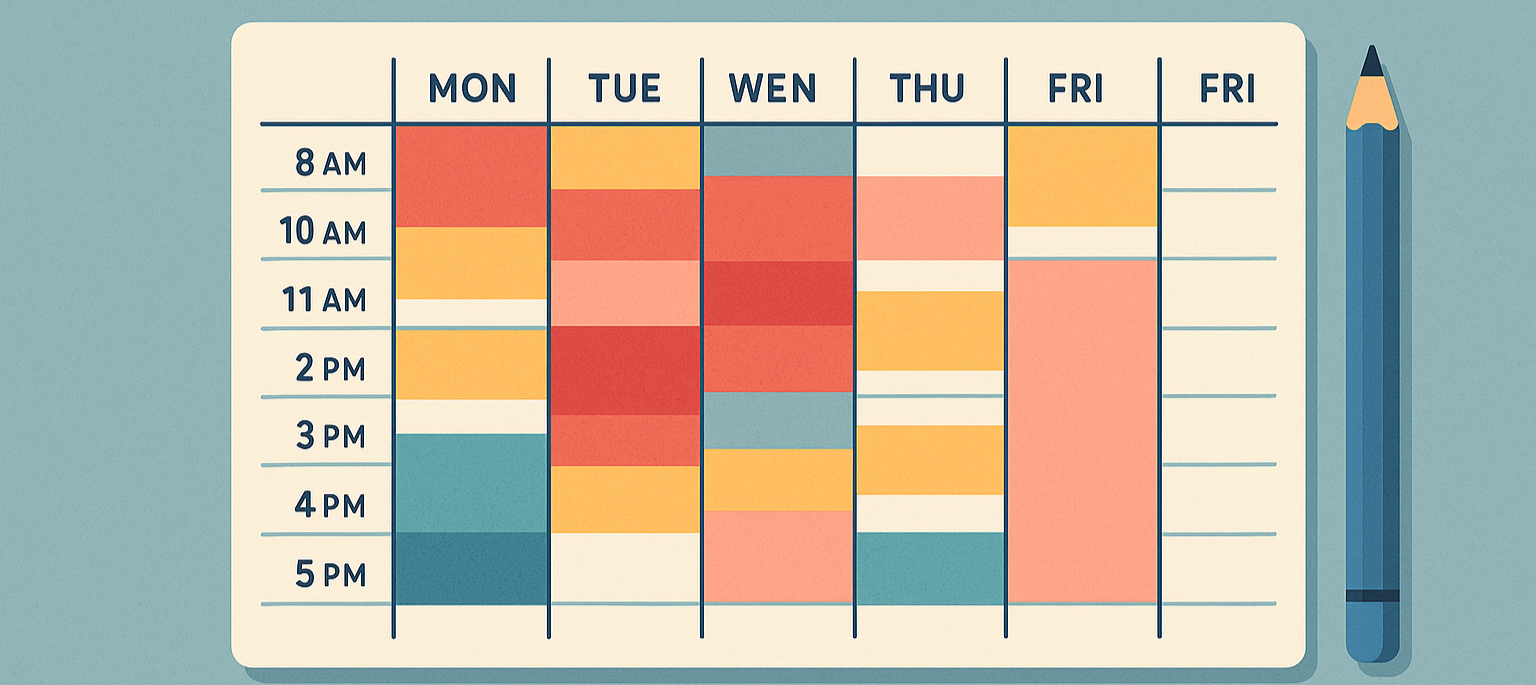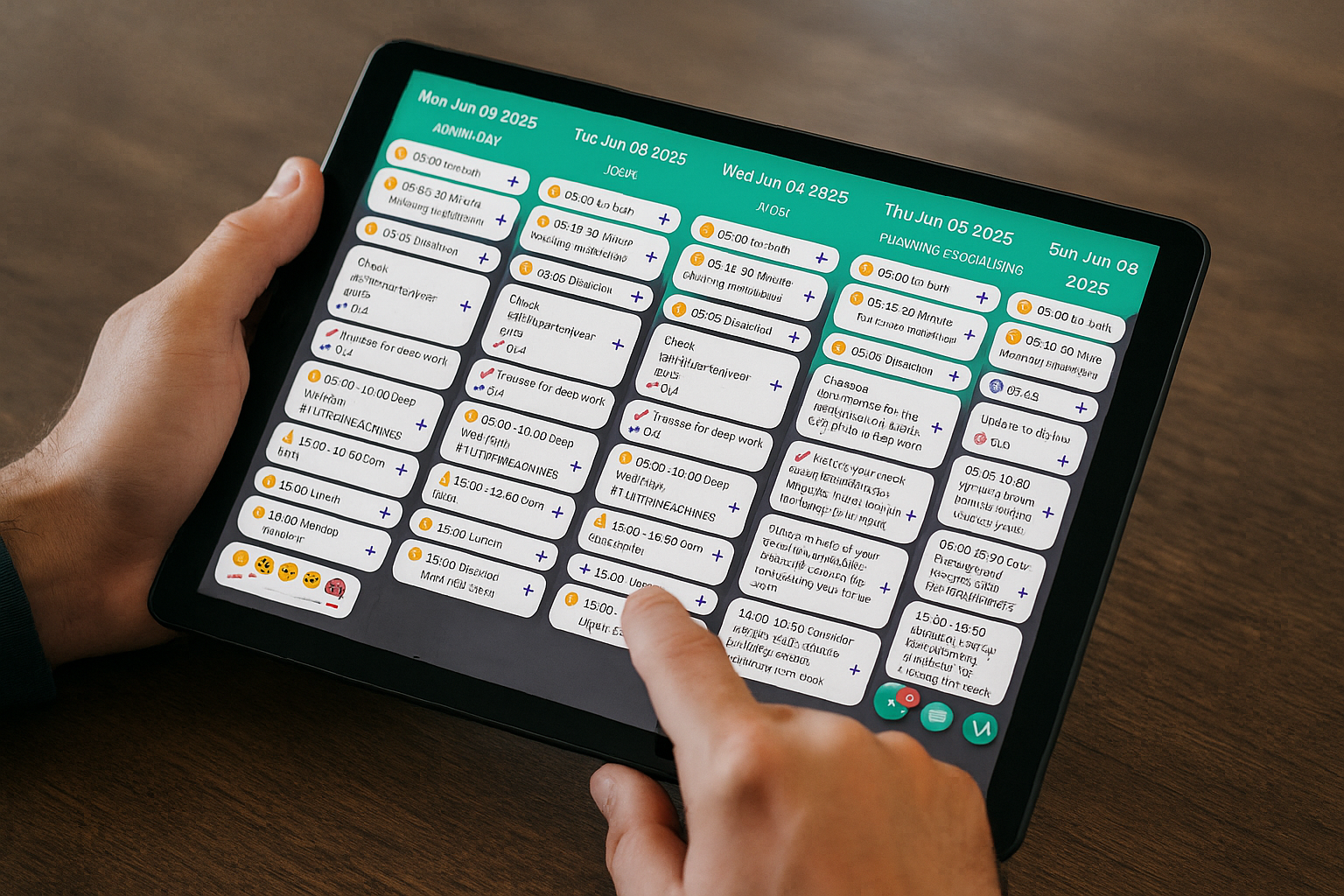ZenDays Logos






Ever found yourself meticulously alphabetising your spice rack instead of tackling the important tasks on your to-do list, only to end up feeling completely paralysed with overwhelm and stress?
Me too. That’s why I’m here to share practical tips to help you combat procrastination.
It might sound hard to believe, but the internet and technology are not the main driving factors of procrastination (although cat-video rabbit holes do make it a lot more fun).
We’ve been dodging to-do lists long before Wi-Fi. Accounts of procrastination go as far back as ancient Greece.
In Plato’s dialogue Protagoras, Socrates famously questions why someone would choose to act contrary to what they believe is best.
A generation later, Aristotle named that paradox ‘akrasia,’ meaning ‘weakness of will,’ to describe this puzzling behaviour of acting against one’s better judgment.
To overcome this deeply human tendency, we first need to understand it. According to the University of Manchester, procrastination tends toward a cyclical pattern which can be hard to break.
So, how do we stop procrastinating?
Studies have shown that procrastination is linked to higher stress and a decline in mental health, which can have negative consequences on your physical health in the long term. Here are some effective strategies to conquer procrastination:
Studies have shown that on average, we experience an interruption every 8 minutes, often taking a few minutes to get back into the task at hand. The compounding effect of that can be catastrophic on your productivity; that’s 60 interruptions in an 8-hour work day.
Here are some steps to take to minimise interruptions and distractions:
You can’t eliminate distractions if you don’t know what’s distracting you. Start taking note of all the things that pull your attention away. Become mindful of the thoughts and feelings, like stress or fatigue, that lead you to distraction. It can be as simple as writing it down on a piece of paper or journaling at the end of the day.
Set a time and place where you focus on deep work without distractions. This means setting up a dedicated workspace, with minimal noise, and turning off all notifications to focus on one task. Using organising methods or a planner like ZenDays can help you set intentions for the time you want to spend on deep work and on smaller tasks.
Tell friends, family and coworkers that you will be unreachable for a set amount of time. Setting these boundaries also means learning to say no to unexpected conversations or tasks that can wait, protecting your focus and energy for what truly matters in the moment.
We’re experiencing a tech addiction epidemic. Research shows that the more time we spend on our phones, the more likely we are to put off real-world tasks. A 2023 meta-analysis of 26 studies found a positive link between smartphone addiction and procrastination tendencies in students.
Here are some tips to reclaim your focus in a digital world:
Time management techniques are the antidote to procrastination; they transform vague intentions into achievable goals. It works because it reduces perfectionism and the all-or-nothing mindset that often pushes people into the procrastination cycle in the first place.
It starts with setting clear priorities, building a realistic schedule, and setting realistic deadlines.
Using a planner is a game-changer for managing your time more effectively. Digital planners like ZenDays are a great tool for creating and customising weekly templates, prioritising tasks, and providing feedback to hold you accountable.
As motivational speaker Jim Rohn famously said, ‘Time is more valuable than money. You can get more money, but you cannot get more time.’
Here are some benefits of using a planner to manage your time:
Categorising tasks helps you step back to identify what’s truly important. This helps structure your day more intentionally, and therefore, you feel less overwhelmed by the number of tasks competing for your attention.
There are many categorising methods, such as the Eisenhower Matrix or the ABCD method, where you split tasks into categories according to urgency.
Here’s how:
1. Make a task list of everything you have to do.
2 Assign categories by using a method like the Eisenhower Matrix (Do, Schedule, Delegate, or Eliminate), the ABC method (A = must-do, B = should-do, C = nice-to-do), or your custom labels.
3. Group tasks visually by using a digital planner, colour codes, or separate lists for each category to make your plan easy to follow.
4. Review and update your categories at the end of each day according to shifting priorities.
5. Break Tasks Into Manageable Steps.
Often, a task is so big and overwhelming, we don’t know where to start. The Swiss Cheese Method is all about making incremental progress. It works by breaking large, daunting tasks into smaller steps you can complete over time.
Here’s how:
As mentioned above in the procrastination cycle, perfectionism and other negative emotions are major drivers of procrastination. These negative feelings drive you further into the procrastination cycle as a coping mechanism.
Here are some ways to combat negative self-talk:
Many people procrastinate because they’re afraid of failure or feel incapable. Approach yourself with kindness instead of judgment by reminding yourself that it’s okay if the outcome isn’t perfect and that setbacks are a normal part of life.
The pressure of overwhelming tasks can send you into analysis paralysis. Remind yourself that one step at a time is okay; often, you’ll build momentum after taking that first step.
Whether it’s breaking a task into smaller steps, using time management techniques, or simply practising self-compassion, you have more control than you think. The key is to start small, poke a hole in that cheese and let momentum do the rest.
Remember that perfection is the enemy of progress. Small, consistent actions are a powerful way to build lasting habits. So next time you catch yourself alphabetising the spice rack, take a breath, pick one thing, and start there. And if you need a little help getting started, ZenDays is here to guide you in the right direction.
Anyone running a business knows that getting leads isn’t an easy task. Pouring money and effort into different systems that, at the end of the day, often just leave you feeling like you are fishing with a broken net.
As someone who also runs a paid ads agency (Snowball Creations), I know that many businesses can struggle to get quality leads. That’s why I decided to give a quick shoutout to Growform. Growform is a powerful form builder specifically designed for lead generation.
This is what separates it from its competitors. It is a game-changer for any business looking to boost its lead-gen efforts without the usual headaches. Here is a quick breakdown of what Growform has to offer.
Nobody likes filling out boring and clunky forms that feel like they serve no purpose. If your form has too many friction points, your potential leads will quickly hit the back button, leaving you with little to show for your efforts.
Growform fixes this by creating multi-step forms that feel smooth, intuitive and way less overwhelming. With the help of conditional logic, businesses can ask more questions than with traditional forms. The end result? More information about your potential prospects that enhances your lead generation quality.
Growform puts customisation fully in your hands, allowing you to create forms that match your brand perfectly. No matter whether you wanna tweak your colours, fonts or even your borders.
You can make sure your form blends seamlessly into your site. Plus, it works beautifully on both desktop and mobile, so you won’t lose potential leads just because they’re filling it out on their phone.
Growform makes it easy to build quality lead forms without the need for developers. No need to hire expensive teams, wait for developers to finish designing or go back and forth with code you don’t understand. At its core, it is just an easy-to-use platform that lets you create exactly what you need, even if you are not a techie.
Oftentimes, you find the perfect tool, but soon realise that it does not play well with other applications. Now, the thing is, no one is looking for another tool that just ends up creating more work for them. Instead, they want the opposite.
With Growform, there is no need to change several software applications that you come to rely on simply because they don’t allow for integration with your essential applications.
With the help of Zapier, Growform integrates with major CRMS, email marketing platforms and automation tools. This allows you to connect with over 300+ destinations without any hassle. You can send leads straight to your email, WhatsApp or SMS. You can also load them into your CRM or have them show up in a Google Sheet, whichever one you prefer.
Growform isn’t just another form builder, it’s a powerful tool specifically built to make lead generation as easy as possible. Between the clean design, conditional logic, full customisation and easy integrations, it’s got everything you need to turn clicks into conversions. It simplifies the process without cutting corners, which is honestly pretty rare these days.
If you’re tired of watching potential customers slip through the cracks, it’s time to give Growform a try. It’s easy to use, helps you capture more leads without the usual friction and integrates seamlessly into your marketing stack. Give your lead generation efforts a serious upgrade today with Growform!
“In the future, a time machine will be built; but no one will have time to use it.” – George Carlin
We all have the same 24 hours a day. Yet somehow, some people glide through life like task-slaying gladiators while the rest of us feel like we’re living Groundhog Day, featuring emails and mild to moderate existential dread.
The secret is not having more time; it’s managing it better. It’s easy to feel overwhelmed in today’s fast-paced world, with endless to-do lists, work responsibilities, family obligations, and unexpected life events.
The good news is that studies have shown that effective time management boosts productivity, reduces stress, and achieves a better work-life balance. Our top time management hacks are easy to implement. Whether you’re tackling work tasks, managing household responsibilities, or working toward personal goals, we’ve got you covered.

Examining your current situation is the first step to better time management. The audit involves logging all your activities and your spending on each. This will give you a clear picture of where you can make improvements.
Step 1: Decide how you will track your activities. You can do this on paper, a productivity app, or a digital planner. ZenDays templating feature is ideal for recording your week and creating a template for your ideal week.
Step 2: Record everything you do for a week. Include admin tasks, work-related activities, and personal activities such as going to the gym, walking the dog, or watching Netflix.
Step 3: Visualise your perfect day, write down everything you see yourself doing.
Step 4: Compare your perfect day with your recorded week. Label the tasks aligned to your values as high-priority in your recorded week. For example, your exercise routine should be a top priority if you value your health. Identify the areas you want to spend less time on.
Step 5: Create an action plan to prioritise important tasks that align with your values and a plan to eliminate the ones that don’t.
Once you can identify where you are compared to where you want to be, it’s easy to implement one of the time management strategies below, such as time-blocking, the two-list strategy, and others.
Popularised by Warren Buffett, arguably one of the most successful figures of our century, his ‘two-list strategy’ is a time management and goal-setting hack he uses to help his employees prioritise.
In a conversation with his longtime pilot, Mike Flint, Buffett shared this approach to help Flint think through his career goals. He asked Flint to write down his top 25 goals and then highlight the 5 that were most important.
When Flint said he’d focus on those top 5 but still work on the rest occasionally, Buffett corrected him. He explained that the other 20 should become an ‘avoid at all costs’ list. The reason for this was not because they weren’t worthwhile, but because they would distract him from what truly matters.
It’s often the tasks you care about but lack fundamental importance that pose the most risk of distracting you. That’s why Buffett’s two-list strategy is so powerful: it helps you avoid ending up with 20 half-finished projects and keeps your focus on the ones that truly matter.
Here’s a quick look at the steps needed for this strategy:
Step 1: Make a list of 25 goals; these can be for your entire career, the year, or a shorter time frame.
Step 2: Highlight the 5 goals that are most important to you.
Step 3: Dedicate all your focus to these 5 goals, and make the rest your ‘avoid at all costs’ list until the 5 top ones are completed.
Time management solutions like ZenDays are not only helpful for planning out your weeks, but also for focusing on goal setting and holding you accountable for them.

Time blocking is a popular time management hack. It is particularly helpful for managing shorter time frames, such as the workday or week ahead.
Step 1: List everything you need to accomplish in the set timeframe. Include administrative tasks, meetings, personal appointments, and even breaks.
Step 2: Prioritise tasks from the most important with tight deadlines to the least important.
Step 3: Decide how long to put aside for each task.
Step 4: Create time blocks on your calendar for the day/week. When the time block is complete, move on to the next block. If you don’t complete a block, keep moving and return to it when you can. At the end of the day, when you review your time blocks, adjust your future blocks to accommodate any unfinished ones.
Time blocking is an effective way to visualise your day, structure it, and stick to it. However, for it to be truly effective, it’s vital to only focus on the tasks in your current block. Grouping similar tasks such as checking email notifications, instant messaging, and calls into one time-block to limit distractions while focusing on tasks.

On average, people check their phones 58 times per day, which is almost 5 times per hour. This simple statistic shows just how distracted we are as a society. Chances are high that you checked your phone before getting to the end of this blog. That’s why best-selling author Cal Newport’s philosophy on deep work is the ultimate hack for making the most out of your valuable time. His theory is that distraction-free deep work is key to mastering new skills and creating high-quality work.
To help people incorporate deep work into their lives, Newport outlines four philosophies for scheduling and organizing deep work:
The Monastic Philosophy is a period of focused, uninterrupted work where distractions and shallow work are eliminated for at least one full day, but can be set for however long is needed to finish a project.
The Bimodal Philosophy consists of blocking dedicated periods to deep work and leaving the rest for shallow work. For instance, setting 4 days per week aside for deep work, and doing admin/ shallow work activities on the last day of the week.
The Rhythmic Philosophy is scheduling a daily time segment to do deep work. This creates deep work as part of the daily routine.
And the Journalistic Philosophy is to fit deep work in whenever possible. This philosophy is likely suitable for people with flexible work schedules who can easily transition into focused states.
Using a planner can be a helpful hack if you’re looking to improve your time management skills. Both digital and traditional planners have their advantages. For example, people who use paper planners may prefer having their calendar on their wall or where they can be reminded of their to-do list. Others may prefer a digital planner because of its customizability and the ability to access it on the go via their mobile device or laptop.
Some questions to consider when choosing which planner suits you best:
Lifestyle: Do you prefer daily, weekly, or longer-term planning? Digital planners are great for long-term planning. They are easily customisable to move things around as things change.
Sharing: Will you be sharing your planner with your work team, family, or for individual use? Some digital planners offer enhanced collaboration features, allowing team members to assign tasks, track progress, and communicate. Printable or paper planners may be more suitable for a family environment to keep track of appointments, sports matches and to-do lists.
Task management efficiency: Which planner would best complement your time management strategies? Digital planners are fantastic for time allocation, allowing you to adjust blocks and add new ones easily. Some also have enhanced features like automated reminders, priority levels, and progress tracking.

Although each hack has slightly different methods, they share a common goal: helping you eliminate distractions, avoid procrastination, and stay focused on the task at hand. Don’t forget to take regular breaks and make time for relaxation to prevent burnout.
Pairing one of these strategies with incorporating a weekly planner like ZenDays into your daily routine will equip you to focus on what truly matters, whether that’s boosting your productivity at work, personal responsibilities, or simply creating a more balanced life.
Have you ever felt like time is slipping away, no matter how hard you try to stay on top of things? Constantly rushing from one task to another, yet your to-do list never seems to shorten. This feeling of pressure around time is known as time anxiety. To put it simply, it is a persistent worry that there’s never enough time to accomplish everything.
Time anxiety can lead to stress, burnout and reduced productivity. Instead of making progress, you find yourself overwhelmed and stuck in a cycle of racing against the clock. This article will explore what time anxiety is, common symptoms you need to look out for and some useful tips to better manage it. Let’s jump in!
Time anxiety is the persistent feeling of extreme fear that you’re not using your time wisely. This translates to stress, which at the end of the day, leads to inefficiency. It’s different from general stress because it specifically revolves around the feeling that time is running out. All of this makes it difficult to focus on the present moment leaving you feeling overwhelmed and full of anxiety.
Constantly rushing through tasks with one eye on the clock as time ticks on might not just be signs of a busy day, but that something more serious is afoot. Here is a quick look at some common time anxiety symptoms:
While those are just some of the symptoms of time anxiety, there are still many others such as constantly worrying, difficulty relaxing, procrastination and the urge to compare yourself to others. To help you overcome time anxiety, it is important to understand what can cause it. According to a statistic from the World Health Organisation (WHO), at any given time they predict that 4% of people experience some form of anxiety disorder. As such it is important to identify some of the causing factors. Here is a quick overview of some of the drivers:
Time anxiety rarely exists in isolation. In many cases, it’s fueled by underlying stress or even other anxiety disorders. If you already struggle with high levels of stress, the added pressure of time slipping away can feel even more intense. Instead of just managing tasks, you’re also battling a constant sense of worry. All of this makes it harder for the person to stay present and in control.

Perfectionism and unrealistic expectations are another common cause of time anxiety. A perfectionist believes that every task should be completed flawlessly and to the best of their abilities. However, if you put too much on your plate, the sheer amount of work can often be so daunting that it leads to procrastination. In fact, even if it is a simplistic task that you are undertaking, but your expectations are too high, it can still lead to you feeling anxious and overwhelmed.
Many people feel intense pressure to maximise every minute. Instead of enjoying the present, their minds jump to what’s next and what they still need to do. This often comes from societal expectations, personal ambition or a fear of missing out (FOMO). All of this creates a constant sense of urgency and stress that further fuels time anxiety.
A never-ending to-do list can feel overwhelming, especially when everything seems equally important. Instead of making progress, you freeze, unsure of where to start. This often leads to procrastination, not because you’re lazy, but because the sheer weight of it all makes it hard to move forward. Meanwhile, the list keeps growing and so does the anxiety.
These days, staying “busy” isn’t just normal, it’s expected. With endless emails, meetings and massive to-do lists, it feels like there’s never enough time to catch up, let alone slow down. The pressure to always be productive turns every moment into a race against the clock, making time anxiety a daily struggle. And when taking a break feels like falling behind, it’s no wonder so many of us feel stuck in a constant state of stress.
The constant fear of disappointing people can also be a major driver for time anxiety. Often when people feel responsible for meeting everyone’s expectations, they start to measure their own worth by how much they get done.
This pressure can make you feel overwhelmed and like you never have enough time for anything. Over time, this mindset can lead to overcommitment, burnout and an inability to just slow down.
Few things feel more unsettling than an unfinished task hanging over your head. It nags at you, pulling your attention away even when you’re trying to relax. Instead of seeing it as an incomplete task and a part of the natural workflow, people with time anxiety take it as a personal failure.
Due to this pressure, you might start rushing through tasks just to get them crossed off the list. Or worse, avoid starting them altogether out of fear you won’t finish in time. Either way, the stress keeps building, making it feel like time is always slipping away faster than you can keep up.
Time anxiety can negatively impact both your mental health as well as your productivity, making simple tasks seem overcomplicated and challenging. It’s like running a race with no clear finish line — you’re always chasing time but never quite catching up to it. Here’s a quick look at the effects time anxiety can have on a person:
Overcoming time anxiety isn’t something that happens overnight, it requires consistent effort and self-compassion. However, with the right strategies, you can regain control and ease the constant stress you feel around time. Here are some tips to help you manage and eventually overcome time anxiety:
A structured approach to tasks can make a big difference. If your to-do list is cluttered with endless tasks or you’re trying to keep everything in your head, you’re setting yourself up for failure. Instead, give your brain a break by using a task management system like ZenDays, or at the very least, a simple notepad that allows you to plan out your daily responsibilities.
A reliable tool can help streamline your tasks, set reminders and keep you on track. This small change can help you feel more in control of your time and lessen the feeling of overwhelm.
While having a well-maintained to-do list is a great place to start, it is only half of the equation solved. Rather than trying to do everything at once, focus on tasks that will make the biggest difference. Consider looking into different productivity systems that will help you prioritise your workload.
For example, you could use the 80/20 rule (Pareto Principle). The Pareto principle states that 80% of results come from 20% of efforts. Identify what your key tasks are that will have the biggest impact and focus on getting them done first. Here’s a quick look at some other productivity systems that can help you better manage your time:
By finding the right productivity system for you, prioritisation becomes second nature and time anxiety starts to loosen its grip.
A great way to help you battle the stress of your workload is to focus on the road you are on and not the countless turns you still need to take. Often, we look at everything we still need to do and get overwhelmed with it all. In many cases, this leads to procrastination which further leads to getting nothing done.
Instead, focus on the task you are busy with and forget the rest. In other words, be more intentional with how you’re spending time. You will get to the other parts when the time comes. Giving your full attention to one task at a time helps you stay present and actually get things done.
This also works well for breaking huge tasks into smaller, more manageable steps. Each time you complete one, you’ll feel a sense of progress instead of drowning in everything left to do. You don’t need to have it all figured out at once — just focus on the step in front of you and the rest will follow.

It’s easy to get caught up in future worries or feel guilty about what you didn’t accomplish. But when your mind is constantly jumping between what’s next and what’s already passed, it becomes harder to focus and even harder to relax. That’s where mindfulness comes in. By practising being fully present in the moment, you break free from that cycle of stress.
Take a few minutes each day to slow down with deep breathing or a short meditation. These techniques help ground you and create a sense of control over your time. Even brief moments of stillness, like stepping outside for fresh air or stretching, can reset your mind and ease the pressure.
By practising mindfulness, you’re training yourself to focus only on what you can control right now. It helps reduce the overwhelming feeling of “I have too much to do” and allows you to approach tasks with a calm mind. It’s less about being perfect and more about being present with what’s in front of you. And the more you practice, the easier it gets to turn that anxiety into a sense of peace and productivity.
Time anxiety doesn’t come from nowhere, specific habits or scenarios activate it. Identifying what sparks your anxiety is the first step to managing it. Once you know your triggers, you can start making small changes to help you manage it. For example, if planning your day overwhelms you, try simplifying the process.
Tools such as ZenDays let you create a weekly template, so you’re not starting from scratch every day. Having a basic structure in place can help reduce decision fatigue and make your workload feel more manageable. Most importantly, let go of the idea that everything needs to be perfect.
Perfectionism is one of the biggest drivers of time anxiety. Perfection keeps you stuck where you are second-guessing and reworking things that are already good enough. The truth is that progress matters more than perfection. Some tasks will not be perfect, but that is okay. The goal isn’t to do everything flawlessly but to get it to a point where it is more than good enough so that you can move on
Time anxiety is a serious issue, but it doesn’t have to control your life. By understanding what it is and what activates it, you can implement practical steps to help you manage it. With the help of time management strategies such as techniques for prioritising tasks, a task management system and a mindset where you embrace imperfection, you can reduce your stress and boost your productivity.
Struggling to make the most of your day? Try ZenDays. It helps you organise tasks, set priorities and stay on track without the overwhelm. Take control of your time and get more done with less stress!
Today’s day and age is so fast-paced that it often feels like you need an extra few hours to get through the day. With so many things happening at the same time, it is easy to feel overwhelmed. That’s why having a set of productivity hacks can make all the difference.
In this article, we will discuss eleven of the best productivity hacks that will not only help you get more done, but also reclaim some of your valuable time so you can focus on what really matters. Let’s dive in!

You can’t have a productive week without clear goals. Make time at the beginning of each week to set goals you want to achieve. Focus on what is top priority and what needs to be done immediately.
By setting goals at the beginning of each week, it provides you with a roadmap of everything that is still on the horizon. Consider using project management tools like ZenDays to help plan your objectives.
Using productivity apps also means tasks are less likely to fall through the cracks and be left incomplete. By starting your week this way you set the tone and the intention for the week ahead.
This is a game changer in the world of productivity. The rule is as follows: If something takes less than two minutes to complete, do it immediately without delay. This can range from answering an email to unpacking the dishwasher. By completing these small routine tasks in the moment, it prevents them from piling up and remaining one of the many unfinished tasks on your to-do list.
The true power of this hack lies in its simplicity. By doing this regularly you free up mental space to focus on more important tasks. Over time, these small actions lead to big results.
Never underestimate the power of a good morning routine. How your morning starts determines the tone for the rest of the day. If you jump out of bed thirty minutes late, rush through the shower, all the while trying to find your keys you can bet you’re probably not going to have the best day.
First, let’s clear up a common misconception about morning routines. You do not need to have an elaborate, long regime for it to be effective. In fact, sometimes keeping it simple is best. A structured morning routine should boost your energy, laser your focus and motivate you.
Try and get up at the same time each morning as this helps to build a habit. Start your mornings with mood energisers — whether that is a quick exercising session, meditation, journaling or quiet time with your first cup of coffee.
Incorporate 5-10 minutes each morning to review your daily tasks and how they align with your weekly goals. These few minutes just after waking up are vital and how you start your day can make a world of difference in how productive you are.

Time blocking is probably one of the most effective ways to ensure you stay on track and maintain focus. By dedicating specific blocks of time to focused work, you minimise the chance of procrastination and distractions.
When used effectively, time blocking helps you to laser focus on specific things that need to get done. You could potentially use your mornings for tasks that require the most attention and keep afternoons for meetings.
You can further perfect this method with the help of a digital planner app. Some apps even allow you to set reminders. This ensures that you don’t forget about what needs to be done. Additionally, a lot of people find it beneficial to see their weekly tasks mapped out in front of them so that they know what to expect.
“Eat the frog” is a productivity concept introduced by Brian Tracy — the author of Eat That Frog. This technique requires you to tackle the most difficult and important task on your to-do list first thing in the morning. Once that “frog” is out of the way, the rest of your day will feel lighter and more manageable.
This method is especially helpful if you are a master procrastinator. It creates momentum at the start of your day and ensures that you tackle what truly matters first thing in the morning.
The truth is that although multitasking feels productive at the moment, it often has the opposite effect. The truth is that multitasking splits your focus, which can lead to you making more mistakes and feeling wrung out.
When you multitask your brain needs time to switch and focus between tasks. This can actually lead to things taking longer than they should. Think of it as opening multiple tabs within your internet browser. The more windows you have open, the slower your computer starts to run as it requires more processing power.
According to research, only 2.5% of people can multitask effectively. This further supports the notion that single-tasking leads to better results and peak productivity. Whenever you have a list of multiple tasks that require your attention, focus on one individual task at a time and see what a difference it makes in your productivity.

Powering through a four-hour work session might seem like the quickest way to get the most things done, but in reality, it is a recipe for disaster. Your brain needs time to rest, reset and refresh. By incorporating regular breaks into your daily routine, you can significantly boost your productivity.
Consider implementing the Pomodoro Method. With this technique, you work for 25 minutes nonstop and then take a 5-minute break. During your breaks intentionally get up from your desk and walk away. Do a quick stretch or grab a glass of water. These small pauses give your brain time to recharge for the work that is still ahead.
We’ve all heard the saying “A cluttered space equals a cluttered mind”. While this is a cliche, it is completely true. It doesn’t matter if you work from home or if you work in an office, if the space is messy chances are it is affecting your mental clarity.
Take a few minutes at the start and end of each day to tidy your office space. Organise stationery, throw out the overflowing bin in the corner and put away those unnecessary papers. Your space should create an environment that fosters concentration and productivity.
The ‘declutter your environment’ rule also applies to your digital space. While it is important to declutter your physical environment, you can’t neglect your digital one. In other words, delete junk mail, sort old files, organise your desktop and put documents in the folders where they belong. A clean, organised space — both physical and digital — contribute greatly to a clear and productive mind.
Planning sessions can feel extremely overwhelming. However, a few well-crafted templates can make the process so much easier. Use a project management tool, such as ZenDays, that allows you to create and customise your own templates.
By incorporating templates, you can structure your week in a way that reduces decision fatigue and can save time in the long run. Consider creating your own schedule template that blocks out time for meetings, deep work and personal appointments. This hack helps streamline your planning process while ensuring you stay consistent.
Task batching is a technique where you group similar tasks together to minimise context-switching. In layman’s terms, this saves your brain the energy of actively switching from one task to the next. This in turn reduces brain fatigue and decreases wasted time.
For example, instead of answering emails and text messages throughout the day, block out a specific time to answer all of them at once. The same can be said for house tasks like washing and doing the dishes. This hack allows you to stay focused for longer periods of time.
Aim to have reflection sessions at the end of each day, or at the least, at the end of each week. Pay special attention to what went well and what needs improvement. Ask yourself about the obstacles you encountered and mark off which goals you reached.
This weekly reflection helps you to celebrate your wins and provides valuable insights for your future planning sessions. Use this time to adjust any strategies that didn’t work well in order to set yourself up for a more productive week ahead.

Working smarter, not harder is the main objective of any productivity hack. By implementing some of the abovementioned tips, you can help take control of your schedule, reduce stress and reach your goals more effectively. These hacks are meant to help you create a healthy work-life balance while helping enhance productivity in your everyday life.
Remember, consistency is key. Try a few of these hacks this coming week and see how they impact not only your workflow but your personal life as well. If you still don’t know where to start, consider using a planner app or simply a piece of paper to better manage your workload. It might just become your secret productivity weapon.
In a world where productivity is king and achieving more is on everyone’s minds, setting goals isn’t just important – they are vital. Although long-term goals like “build a successful business”, “pay off my credit card debt” or “grow my YouTube channel” sound inspiring, they can often also feel extremely overwhelming. This is where the majority of people fall flat on achieving their personal goals. But it doesn’t have to be like this.
Another year does not have to pass you by without you achieving your objectives — this is where short-term goals come in. These pint-sized targets help you stay motivated, track measurable results and work towards making your desired outcome a reality.
In this article, we will explore what short-term goals are, their associated benefits, how they differ from long-term goals and how to set them up practically.

As mentioned above, short-term goals are pint-sized objectives you aim to complete over a short period of time, usually to aid you in achieving bigger, more long-term goals. These short-term objectives are usually achieved in the near future, spanning anywhere from a few days to a few months. They are specifically designed to help you see progress without feeling overwhelmed by the bigger picture. They are specific, actionable and measurable.
Think of short-term goals as stepping stones leading to your biggest dream. Alone one stepping stone seems insignificant, but together they will get you closer to the end result. Just remember progress is progress, no matter how small.
Let’s put it into practice. Say for example a long-term goal for you is to start a blog channel. You can’t just jump in and start posting. This big dream needs to be broken down into smaller goals in order to achieve the big one.
Short-term goals could include first researching how to start a blog, then choosing a niche, brainstorming your first ten posts and ultimately setting up a website. By breaking down this big goal into smaller bite sizes, you make them more manageable and considerably increase the likelihood of success.
A lot of people might wonder why they should even bother with short-term goals. Especially if the short-term goal does not directly support the long-term objective. Well, the truth is the benefits extend far beyond simply checking off a few items on your to-do list. Here is a quick look at four advantages of setting short-term goals:
Short-term goals help to remove the ‘noise’ around you. They help to keep your attention on what task is directly in front of you. Instead of getting lost or overwhelmed by the bigger picture — your long-term goals, they help you zoom in on the immediate steps you need to take. All of this keeps you on track and allows you to reach your goals.
Short-term goals have a way of tricking your brain and increasing dopamine release. Nothing feels better than crossing something off of your to-do list and having the satisfaction of knowing you reached your objective. These frequent wins help build momentum and keep you motivated.
The truth is a lot of the times we write down long-term objectives without thinking of the steps we need to take in order to get to them. Then after a few months you look at them again and you feel anxious and extremely overwhelmed.
This often leads to people just giving up. However, with short-term goals these big aspirations are broken down into smaller pieces, which makes it feel more manageable and less overwhelming.
If we’re being honest, everyone likes to feel like they are winning at something. Finishing and ticking off any item on your to-do list makes you feel like you are accomplishing something worthwhile. This leads to you chasing that ‘high’ and doing it over and over again.
While building the initial habit is not always a quick process, it is a rewarding pursuit. According to James Clear — author of Atomic Habits — it takes 66 days to form a habit. Over time, as this habit becomes automatic, you’ll find yourself naturally tackling your short-term goals and procrastinating less about what you still need to do.
A common misconception is that by focusing on short-term goals, you are neglecting your long-term objectives. However, this is simply not the case. In reality, short-term and long-term goals work in tandem. Long-term objectives usually have a time frame of three to ten years, whereas short-term goals range from a few days to a few months.
The one is supposed to support the other. Think of them as your favorite movie. The leading actor probably would not have been as funny or heroic without his supporting side-kick best friend. That’s how the relationship should be between long and short-term goals.
Long-term objectives represent the ultimate destination, the crème de la crème of life if you will. However, without a map leading you to this destination, you feel lost and overwhelmed.
That’s exactly what short-term goals help to accomplish. Think of them as a road map of sorts leading you to your final destination. In other words, they are the actionable steps that bridge the gap between long-term goals remaining a dream vs. becoming a reality.
Setting goals sounds really simple, but when it comes to actually putting pen to paper, a lot of people become overwhelmed. This is where effective strategy and planning comes in. Once you know how, it is actually quite simple from there. Here are four ways you can set short-term goals that work:
Whether it has to do with your personal development or your professional life, SMART goals are a way to set realistic objectives that keep you focused and motivated throughout the process. For a goal to fall under the SMART umbrella, it needs to adhere to five factors. Here’s a more in-depth look at these components:
Instead of setting a vague goal such as: “I want to become more fit”. Use the SMART method to set measurable goals. For example: “I want to run a 5K within 30 minutes by training three times a week for the next eight weeks.” This way you create a clear framework of what you need to accomplish.
Big tasks often feel overwhelming and sometimes just downright scary. Breaking big tasks into smaller more manageable chunks relieves stress and reduces the risk of you getting overwhelmed. One example could be that you want to declutter your entire home. That in itself feels intimidating and when looking at the task ahead it is easy to quickly lose motivation.
Instead, take it one room or even one drawer at a time. Another way to break it down even further is to add a daily reminder to your productivity app to “declutter for 10 minutes”. This way you only have a set amount of time per day to work on it. This daily habit can quickly help you stay on top of your goals.
Not all tasks are equal in weight or importance. Focus on the ones that are crucial or have a deadline associated with them. You could even implement a productivity method or try a coding system where you rate each priority. You usually use the numbers 1, 2 and 3.
When a task is categorised as a 1 it is super important and time sensitive. 2 is usually things that are important and moderately time sensitive. Meaning, if you don’t get to it immediately you still have a bit of wiggle room left. Tasks with a level 3 rating are usually not that important or time sensitive at that specific moment. Remember, task ratings can change as time goes on, just adjust accordingly.

Consider using a project management tool like ZenDays to help you manage both long-and short-term goals. You can set your long-term objectives and break them down into daily or weekly tasks (short goals). This will ensure steady progress without losing sight of the ultimate destination.
Even the best laid-out plans can fail when obstacles present themselves. Here’s how to beat common challenges if and when they arise:
Remember, setbacks are normal. Just keep moving forward, even if it’s just one small step at a time. Try to implement the rule of never missing two consecutive days of tracking and working on your short-term goals. One is fine, two become a habit.
The best goal is one checked off of a to-do list. Here are three steps you can follow to integrate short-term goals into your daily routine:
Tracking progress is not just about ticking something off a list, it is also extremely motivating. Take time to celebrate your wins, no matter how small.
By continuously tracking your progress you can also adjust your short-term goals as needed. Sometimes you need more time than you thought for a certain task, and other times you progress faster.
Remember, you are in charge of your own goals. If you need more time or if you need to change things up a bit, you can. Just don’t become stagnant and try to always challenge yourself a bit.

It is true, Rome was not built in a day. Nor can you expect success to happen overnight. If achieving goals (long and short term) were easy, everyone would be doing it left and right. But with the use of short-term goals you can break down intimidating long-term aspirations into smaller measurable stepping stones.
By focusing on what you can achieve over a short period of time, you will build the habits and momentum needed to move you closer to your dreams — whether that is in your professional or personal life. With the right tools and systems in place, success is not only probable but imminent.